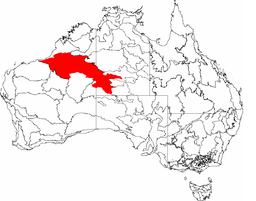Great Sandy Desert
| Great Sandy | |
| Desert | |
|
A Landsat 7 image of the Great Sandy Desert
|
|
| Nickname: GSD | |
| Country | Australia |
|---|---|
| State/Territory | Western Australia, Northern Territory |
| Area | 284,993 km2 (110,036 sq mi) |
| Biome | Desert |
|
The IBRA bioregions, with the Great Sandy Desert in red
|
|
The Great Sandy Desert, an interim Australian bioregion, is located in the North West of Western Australia straddling the Pilbara and southern Kimberley regions. It is the second largest desert in Australia after the Great Victoria Desert and encompasses an area of 284,993 square kilometres (110,036 sq mi) The Gibson Desert lies to the south and the Tanami Desert lies to the east of the Great Sandy Desert.
The Great Sandy Desert contains large ergs, often consisting of longitudinal dunes. In the North East of the desert, there is a well known meteorite impact crater, i.e. the Wolfe Creek.
The region is sparsely populated. The main populations consist of Indigenous Australian communities and mining centers. The aboriginal people of the desert fall into two main groups: the Martu in the west and the Pintupi in the east. Linguistically, they are speakers of multiple Western Desert Languages. Many of these indigenous people were forcibly removed from their lands during the 20th century and relocated to settlements such as Papunya in the Northern Territory. In recent years, some of the original inhabitants have returned. Young Indigenous adults from the Great Sandy Desert region travel to and work in the Wilurarra Creative programs to maintain and develop their culture.
Rainfall is low throughout the coast and far north and is strongly seasonal. Areas near the Kimberley have an average rainfall that exceeds 300 mm (12 in), but is patchy. Many drought years end with a monsoon cloud mass or tropical cyclone. Like many of Australia's deserts, rainfall is high by desert standards, with the driest parts recording falls little below 250 mm (9.8 in). A massive evaporation rate makes up for the higher than normal desert rainfall. This region is one which gives rise to the heat lows which help drive the NW monsoon. Almost all rain comes from monsoon thunderstorms, or the occasional tropical cyclone rain depression.
...
Wikipedia


